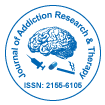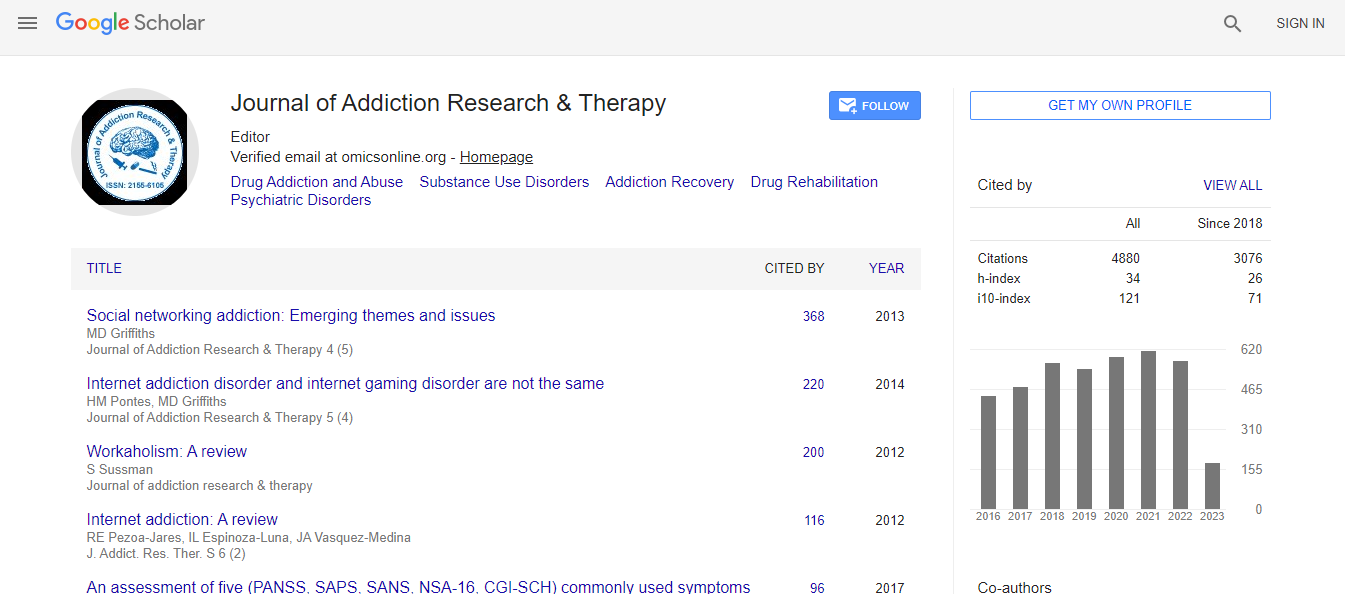OMICS International organises 3000+ Global Conferenceseries Events every year across USA, Europe & Asia with support from 1000 more scientific Societies and Publishes 700+ Open Access Journals which contains over 50000 eminent personalities, reputed scientists as editorial board members.
Open Access Journals gaining more Readers and Citations
700 Journals and 15,000,000 Readers Each Journal is getting 25,000+ Readers
Google Scholar citation report
Citations : 4859
Journal of Addiction Research & Therapy received 4859 citations as per Google Scholar report
Journal of Addiction Research & Therapy peer review process verified at publons
Indexed In
- CAS Source Index (CASSI)
- Index Copernicus
- Google Scholar
- Sherpa Romeo
- Open J Gate
- Genamics JournalSeek
- Academic Keys
- JournalTOCs
- SafetyLit
- China National Knowledge Infrastructure (CNKI)
- Electronic Journals Library
- RefSeek
- Hamdard University
- EBSCO A-Z
- OCLC- WorldCat
- SWB online catalog
- Virtual Library of Biology (vifabio)
- Publons
- Geneva Foundation for Medical Education and Research
- Euro Pub
- ICMJE
Useful Links
Recommended Journals
Related Subjects
Share This Page
Journal of Addiction Research & Therapy : Citations & Metrics Report
Articles published in Journal of Addiction Research & Therapy have been cited by esteemed scholars and scientists all around the world. Journal of Addiction Research & Therapy has got h-index 34, which means every article in Journal of Addiction Research & Therapy has got 34 average citations.
Following are the list of articles that have cited the articles published in Journal of Addiction Research & Therapy.
| 2024 | 2023 | 2022 | 2021 | 2020 | 2019 | 2018 | 2017 | 2016 | |
|---|---|---|---|---|---|---|---|---|---|
Total published articles |
88 | 88 | 61 | 59 | 24 | 28 | 24 | 59 | 48 |
Research, Review articles and Editorials |
20 | 68 | 49 | 7 | 8 | 18 | 0 | 0 | 0 |
Research communications, Review communications, Editorial communications, Case reports and Commentary |
68 | 0 | 1 | 15 | 3 | 1 | 0 | 0 | 0 |
Conference proceedings |
0 | 11 | 5 | 0 | 0 | 0 | 85 | 56 | 105 |
Citations received as per Google Scholar, other indexing platforms and portals |
90 | 168 | 573 | 612 | 590 | 545 | 567 | 473 | 440 |
| Journal total citations count | 4859 |
| Journal impact factor | 9.79 |
| Journal 5 years impact factor | 14.65 |
| Journal cite score | 13.41 |
| Journal h-index | 34 |
| Journal h-index since 2019 | 26 |
Chen L, Nath R (2016) Understanding the underlying factors of Internet addiction across cultures: A comparison study. Electronic Commerce Research and Applications 17: 38-48. |
|
| View at Publisher | View at Google Scholar | |
Jeromin F, Rief W, Barke A (2016) Validation of the Internet Gaming Disorder Questionnaire in a Sample of Adult German-Speaking Internet Gamers. Cyberpsychology, Behavior, and Social Networking 19: 453-459. |
|
| View at Publisher | View at Google Scholar | |
Jeromin F, Nyenhuis N, Barke A (2016) Attentional bias in excessive Internet gamers: Experimental investigations using an addiction Stroop and a visual probe. Journal of Behavioral Addictions 5: 32-40. |
|
| View at Publisher | View at Google Scholar | |
Tolchard B (2016) Cognitive-behavior therapy for problem gambling: a critique of current treatments and proposed new unified approach. Journal of Mental Health 14: 1-8. |
|
| View at Publisher | View at Google Scholar | |
Harris N, Mazmanian D (2016) Problem Internet Gamblers’ Perspectives on Cognitive Behavioural Group Therapy. International Journal of Mental Health and Addiction 14: 885-895. |
|
| View at Publisher | View at Google Scholar | |
Nower L, Caler K. Encyclopedia of Social Work. |
|
| View at Publisher | View at Google Scholar | |
Beard E, Brown J, Kaner E, West R, Michie S (2017) Predictors of and reasons for attempts to reduce alcohol intake: A population survey of adults in England. PLoS one 12: e0173458. |
|
| View at Publisher | View at Google Scholar | |
Leeman RF, Patock-Peckham JA, Potenza MN (2012) Impaired control over alcohol use: An under-addressed risk factor for problem drinking in young adults?. Experimental and clinical psychopharmacology 20: 92. |
|
| View at Publisher | View at Google Scholar | |
Elmore JS, Dillon-Carter O, Partilla JS, Ellefsen KN, Concheiro M, et al. (2016) Pharmacokinetic Profiles and Pharmacodynamic Effects for Methylone and Its Metabolites in Rats. Neuropsychopharmacology. |
|
| View at Publisher | View at Google Scholar | |
Burrows BT, Watterson LR, Johnson MA, Olive MF (2015) Effects of modafinil and R-modafinil on brain stimulation reward thresholds: implications for their use in the treatment of psychostimulant dependence. Journal of drug and alcohol research. |
|
| View at Publisher | View at Google Scholar | |
Woloshchuk CJ, Nelson KH, Rice KC, Riley AL (2016) Effects of 3, 4-methylenedioxypyrovalerone (MDPV) pre-exposure on the aversive effects of MDPV, cocaine and lithium chloride: Implications for abuse vulnerability. Drug and Alcohol Dependence 167: 121-127. |
|
| View at Publisher | View at Google Scholar | |
Baumann MH, Bukhari MO, Lehner KR, Anizan S, Rice KC, Concheiro M, Huestis MA. Neuropharmacology of 3, 4-Methylenedioxypyrovalerone (MDPV), Its Metabolites, and Related Analogs. |
|
| View at Publisher | View at Google Scholar | |
Anneken JH, Angoa-Pérez M, Sati GC, Crich D, Kuhn DM (2017) Dissecting the Influence of Two Structural Substituents on the Differential Neurotoxic Effects of Acute Methamphetamine and Mephedrone Treatment on Dopamine Nerve Endings with the Use of 4-Methylmethamphetamine and Methcathinone. Journal of Pharmacology and Experimental Therapeutics 360: 417-423. |
|
| View at Publisher | View at Google Scholar | |
Botanas CJ, Yoon SS, de la Peña JB, dela Peña IJ, Kim M, et al. (2017) A novel synthetic cathinone, 2-(methylamino)-1-(naphthalen-2-yl) propan-1-one (BMAPN), produced rewarding effects and altered striatal dopamine-related gene expression in mice. Behavioural brain research 317: 494-501. |
|
| View at Publisher | View at Google Scholar | |
Oh JH, Hwang JY, Hong SI, Ma SX, Seo JY, et al. (2016) The new designer drug buphedrone produces rewarding properties via dopamine D1 receptor activation. Addiction biology. |
|
| View at Publisher | View at Google Scholar | |
|
|
| View at Publisher | View at Google Scholar | |
Fratantonio J, Andrade L, Febo M (2015) Designer Drugs: A Synthetic Catastrophe. Journal of reward deficiency syndrome 1: 82. |
|
| View at Publisher | View at Google Scholar | |
Daniel JJ, Hughes RN (2016) Increased anxiety and impaired spatial memory in young adult rats following adolescent exposure to methylone. Pharmacology Biochemistry and Behavior 146: 44-49. |
|
| View at Publisher | View at Google Scholar | |
|
|
| View at Publisher | View at Google Scholar | |
Aarde SM, Taffe MA. Predicting the Abuse Liability of Entactogen-Class, New and Emerging Psychoactive Substances via Preclinical Models of Drug Self-administration. |
|
| View at Publisher | View at Google Scholar | |


